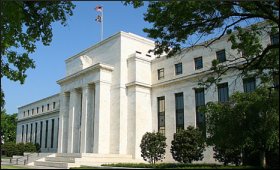|

|
Yellen has played it smart, now Rajan has to make up
|
|

|
|
| Top Stories |
 |
|
|
|
Vatsal Srivastava | 18 Sep, 2015
Acknowledging the recent volatile developments in the global markets, most notably China, and low inflation, US Federal Reserve Chair Janet Yellen has decided to keep interest rates near the zero-bound. This outcome was widely expected by the financial markets, as federal fund futures were only anticipating a 30 percent probability of a September liftoff.
But US monetary normalisation is inevitable and most likely we will see a rate hike this year. A majority in the Federal Open Market Committee sees a rate hike sometime in 2015 and Yellen also said a rate-hike policy decision will be followed by a press conference.
This implies that an October liftoff is out of the picture and a December move is very much on the cards, provided global volatile conditions in the financial markets abate, particularly in China and emerging markets. Yellen reaffirmed that the US labour market remains 'solid' and that the committee is confident of meeting its long-term inflation target of 2 percent, even though falling energy prices have subdued their outlook for inflation in the short term.
The market reaction was mixed but the message is quite clear: US economic recovery remains robust. Expect a rate hike in 2015, but don't focus too much on the timing of this hike. Rather, look at the path of monetary tightening, which will remain highly "accommodative" according to Yellen.
With the Fed meeting out of the way, and the September 20 Greek election likely to be a non-event for global markets, the domestic focus will turn to the Reserve Bank of India (RBI) meet on September 29. The ball is now in Rajan's court. He must stop obsessing with the timing of the US Fed hike.
India's macros -- inflation, current account deficit and foreign exchange reserves -- are in a much stronger position than they were during the USA's "taper tantrum" in 2013. Of course, there will be an outflow of capital when the US Fed hikes rates - whether in December or early 2016. It's inevitable and it makes no sense in trying to time India's own monetary policy stance ith the Fed lift-off as short-term consequences cannot be wished away.
Accordingly, the Reserve Bank of India must drop its ultra-hawkish stance urgently.
On Thursday, RBI Deputy Governor Urjit Patel reiterated that India needs sustained low inflation to achieve a lower cost of capital for industry. A sharp drop in real rates and the cost of capital is a necessary condition for the investment cycle to pick up.
But how soft must the inflation data get in order for the Indian central bank to turn aggressively accommodative? It is highly likely that the 6 percent inflation target of the RBI for January 2016 based on retail prices will undershoot by a huge margin, which can even be north of 100 basis points. The retail inflation has fallen from 5.4 percent in June to 3.7 percent in August.
According to JPMorgan analysis, the inflation momentum -- quarter-on-quarter seasonally-adjusted and then annualised -- is down from 6.6 percent in June to 4.9 percent in July and just 2.7 percent in August. India's wholesale price inflation, currently at (-)4.95 percent entered the negative territory in November 2014 and has stayed below the line since then. This reading is: It will still be in the negative zone even after stripping out the tradable component part.
Rajan has missed the bus when it comes to easing monetary conditions. Given the current inflation outlook, he should now be focusing on accelerating India's GDP growth towards its potential of 8-10 percent.
A 25 basis point cut just won't do it. To make up for the delay and infuse confidence in the financial system, Rajan will have to deliver a 50 basis point cut, along with sounding dovish about the immediate future.
(Vatsal Srivastava is consulting editor with IANS. The views expressed are personal. He can be reached at vatsal.sriv@gmail.com)
|
|
|
| |
|
|
|
|
|
|
|
|
|
|
|
|
|
|
| |
| Customs Exchange Rates |
| Currency |
Import |
Export |
US Dollar
|
84.35
|
82.60 |
UK Pound
|
106.35
|
102.90 |
Euro
|
92.50
|
89.35 |
| Japanese
Yen |
55.05 |
53.40 |
| As on 12 Oct, 2024 |
|
|
|
|
|
|
|
| Commented Stories |
 |
|
|
|
|
|
| |
|